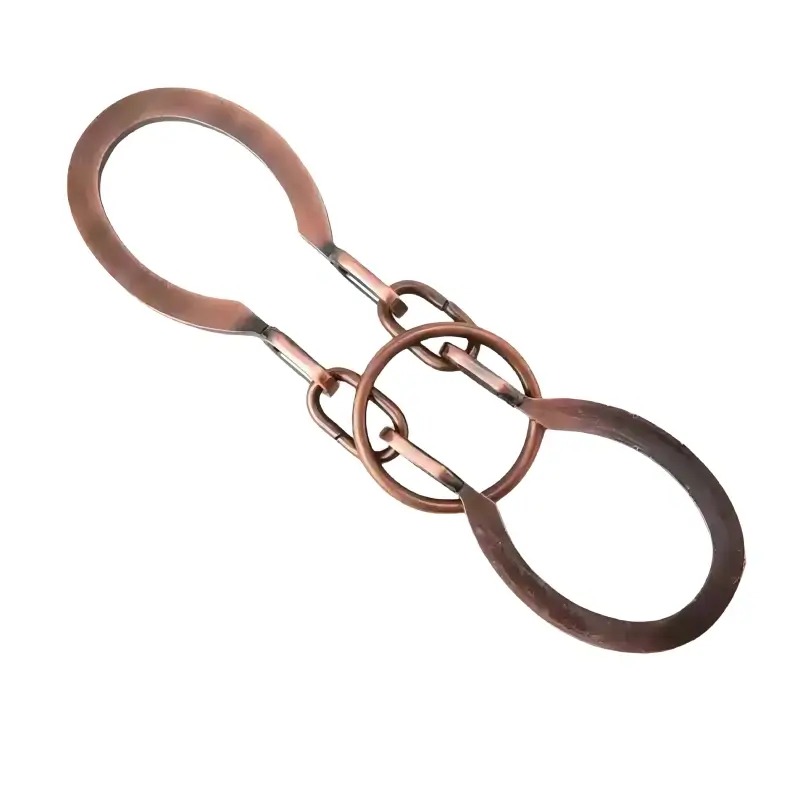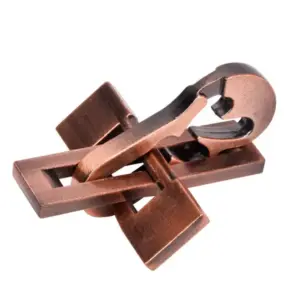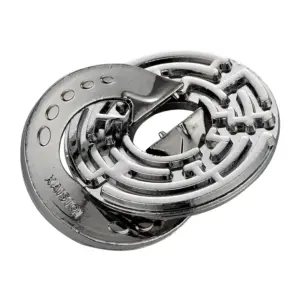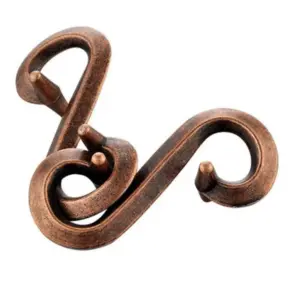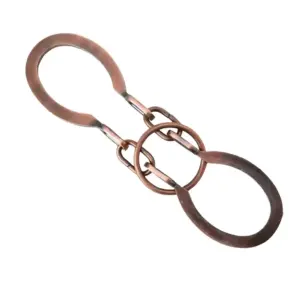Discover the fascinating world of the Horseshoe Lock Puzzle, a traditional Chinese mental challenge that combines elegant simplicity with deceptive complexity, and learn the step-by-step technique to master it.
The Enigmatic Allure of the Horseshoe Lock Puzzle
In a world saturated with digital diversions and fleeting entertainment, there exists a tangible challenge that has stood the test of time – the Horseshoe Lock Puzzle. This ingenious contraption, originating from ancient Chinese intellectual traditions, represents a perfect marriage of simplicity and complexity. At first glance, the puzzle presents itself with disarming modesty: two horseshoe-shaped metallic components connected by sturdy chains, with a solid metal ring seemingly imprisoned within this clever arrangement. Your mission, should you choose to accept it, is deceptively straightforward – liberate the captive ring and then, proving your complete mastery, return it to its original configuration.
What elevates this particular brain teaser beyond the realm of ordinary puzzles is the tantalizing dichotomy between its apparent impossibility and the elegant solution concealed within its design. Unlike the disposable plastic amusements that populate contemporary toy stores, the Horseshoe Lock Puzzle carries within its metallic frame the gravitas of historical significance and the patina of timeless design. Each attempt to unravel its secrets connects you to an invisible lineage of problem-solvers throughout history who have furrowed their brows in concentration before experiencing the same sublime moment of revelation.
The puzzle’s enduring popularity stems from its remarkable ability to challenge novices and veterans alike. It doesn’t discriminate based on age, education, or background – it simply presents a universal challenge to human ingenuity. Those who encounter it for the first time often cycle through predictable stages: confusion, determination, frustration, and finally – for the persistent – exhilaration upon discovery of the solution. This emotional journey is precisely what has cemented the Horseshoe Lock Puzzle’s status as a classic among mental challenges.
The Architectural Genius Behind the Deception
The devilish ingenuity of the Horseshoe Lock Puzzle lies in its deceptive architectural simplicity. Two horseshoe-shaped metallic pieces, permanently joined with short, robust chain segments, form a semi-enclosed structure that appears to completely entrap a solid metal ring. To the uninitiated observer, this configuration presents an apparent paradox – the ring seems unequivocally imprisoned with no conceivable escape route that doesn’t involve damaging the puzzle itself.
The puzzle’s effectiveness as a brain teaser stems from its exploitation of conventional thinking patterns. Most people instinctively attempt to navigate the ring through various openings, pulling and maneuvering in increasingly frustrated attempts to find a path to freedom. This approach, while natural, ultimately proves futile – and therein lies the puzzle’s brilliant deception. The solution doesn’t reside in finding an existing escape route, but rather in creating one through a specific manipulation of the horseshoe components.
Horseshoe Lock Puzzle
Classic Horseshoe Puzzle: The Ancient Brainteaser That Challenges Your Wits
- CHALLENGING BRAIN TEASER: Test your problem-solving skills with this traditional Chinese metal puzzle that looks simple but requires clever manipulation
- AUTHENTIC DESIGN: Features two interlocked metal horseshoes and a seemingly impossible-to-remove solid ring
- PERFECT GIFT: An ideal present for puzzle enthusiasts, collectors, or anyone who enjoys mind-bending challenges
- BRINGS GOOD FORTUNE: Horseshoes are a traditional symbol of luck in many cultures
- DURABLE CONSTRUCTION: Crafted from high-quality metal for a premium feel and years of puzzling enjoyment
What makes this puzzle particularly gratifying is the transformative moment of comprehension when the seemingly impossible suddenly becomes achievable through a specific technique. Unlike many contemporary challenges that reward brute force or random attempts, the Horseshoe Lock Puzzle demands a more refined approach – one that combines spatial reasoning with methodical experimentation. The solution doesn’t require exceptional strength, specialized knowledge, or elaborate equipment – just pure logical thinking and three-dimensional visualization. Each successful resolution reinforces cognitive flexibility and provides that distinctive “eureka!” moment that puzzle enthusiasts covet.
Furthermore, the puzzle’s design incorporates an additional layer of complexity by requiring the solver to return the ring to its original position. This symmetrical challenge ensures that true mastery involves understanding the puzzle’s mechanics completely, rather than stumbling upon a one-way solution. It’s this roundtrip journey – from assembled to disassembled and back again – that distinguishes the true puzzle virtuoso from the merely lucky tinkerer.
The Psychological Benefits of Metallurgical Mind-Bending
The Horseshoe Lock Puzzle offers far more than mere entertainment; it provides a fascinating window into the psychology of problem-solving and the architecture of human cognition. When confronted with this metallic enigma, our brains engage in a complex dance of analytical thinking, spatial reasoning, and creative problem-solving – a cognitive workout that neurologists and psychologists increasingly recognize as beneficial for maintaining mental agility throughout life.
Studies consistently demonstrate that engaging with mechanical puzzles like the Horseshoe Lock activates multiple regions of the brain simultaneously, creating new neural pathways and strengthening existing ones. This form of mental exercise has been linked to improved cognitive reserve – the brain’s resilience against age-related decline and degenerative conditions. By challenging established patterns of thinking and forcing novel approaches to problem-solving, such puzzles effectively serve as gymnasium equipment for the mind.
Perhaps the most psychologically satisfying aspect of the Horseshoe Lock Puzzle lies in what psychologists term the “flow state” – that rare condition of complete immersion and focused concentration where time seems to dissolve, and self-consciousness evaporates. Unlike digital distractions that fracture attention through constant notifications and stimuli, this tangible puzzle demands total engagement, creating a meditative quality that many find increasingly precious in our fragmented digital landscape.
The frustration that inevitably accompanies early attempts at solving the puzzle also serves a valuable psychological purpose. In an era where instant gratification has become the expectation rather than the exception, the Horseshoe Lock Puzzle teaches patience and persistence – qualities that translate directly to success in professional and personal spheres. Those who persevere through initial failures develop greater resilience, learning to view obstacles as temporary challenges rather than permanent roadblocks.
Furthermore, the moment of revelation – when the solution suddenly becomes clear – triggers a delightful neurochemical reward in the form of dopamine release. This natural high serves as positive reinforcement for intellectual perseverance and creates an association between mental effort and pleasure that can foster lifelong learning habits. In essence, the puzzle doesn’t just entertain; it fundamentally recalibrates our relationship with challenges.
The Symbolic Significance of the Horseshoe Form
The horseshoe element of this puzzle is far from arbitrary; it taps into a rich vein of symbolism that spans cultures and centuries. Throughout human history, the horseshoe has occupied a privileged position in the pantheon of lucky symbols – from ancient protection against malevolent spirits to modern-day good fortune charms. This culturally resonant shape imbues the puzzle with meaning beyond its mechanical challenge.
In Western traditions, the horseshoe’s luck-bringing properties are typically attributed to its crescent shape (resembling the moon, which was often associated with feminine deities and fertility) and to its traditional construction from iron, a metal believed to ward off evil entities. The specific orientation of the horseshoe has sparked debate throughout history – some traditions insist that the ends must point upward to contain good fortune, while others maintain that downward-pointing ends allow luck to pour onto those who pass beneath.
Eastern traditions, particularly in Chinese culture where this puzzle originated, view the horseshoe shape differently but no less significantly. Its curved form evokes the concept of “embracing chi” or life energy, creating a vessel for positive forces. The metal composition connects to the five elements philosophy, representing strength, persistence, and transformation – qualities that parallel the mental attributes required to solve the puzzle itself.
This symbolic dimension transforms the Horseshoe Lock Puzzle from mere entertainment into a meaningful object that can be displayed proudly in homes or offices. It becomes a conversation piece that subtly communicates the owner’s appreciation for both intellectual challenges and cultural traditions. When presented as a gift, it conveys thoughtfulness on multiple levels – offering not just a pleasant diversion but also a symbolic token of good fortune.
The horseshoe’s association with journeys and transportation adds yet another layer of metaphorical resonance. Just as horses carried travelers across difficult terrain throughout history, the mental journey required to solve this puzzle transports the mind across unfamiliar cognitive landscapes, ultimately arriving at a destination of satisfaction and accomplishment.
The Mechanical Principles: Understanding How the Puzzle Works
The Horseshoe Lock Puzzle exemplifies the principle that true elegance lies in simplicity – a concept revered in both engineering and aesthetic disciplines. Despite its uncomplicated appearance, the puzzle employs sophisticated mechanical concepts that have delighted and confounded generations of puzzle enthusiasts. Understanding these principles provides not only the key to solving the puzzle but also a deeper appreciation for its ingenious design.
At its core, the puzzle consists of three primary components: two horseshoe-shaped metal pieces and a solid metal ring. The horseshoes are permanently connected by short chains, forming what mathematicians would recognize as a topologically complex arrangement. This configuration creates a semi-enclosed structure that appears to completely entrap the ring with no obvious exit path. The puzzle’s challenge stems from the fact that the ring cannot be simply slipped off the ends of the horseshoes or squeezed through the chain links.
The solution exploits a principle that engineers and physicists recognize as a transformation of three-dimensional space – specifically, by manipulating the orientation of the horseshoes relative to each other, a temporary opening is created that allows the ring to escape its apparent imprisonment. This principle demonstrates how apparently closed systems can contain hidden degrees of freedom that become apparent only through specific manipulations.
What makes this puzzle particularly fascinating from a mechanical perspective is how it leverages our perceptual limitations. Human beings naturally think in terms of static configurations rather than dynamic transformations. When we observe the assembled puzzle, our minds instinctively interpret it as a fixed structure rather than a system of movable parts with untapped potential configurations. This cognitive bias – seeing only what is, rather than what could be – forms the primary barrier to solving the puzzle.
The precision engineering required to create an effective Horseshoe Lock Puzzle should not be underestimated. The dimensions must be carefully calibrated – if the chains are too long or the horseshoes improperly proportioned, the puzzle becomes either trivially easy or frustratingly impossible. Similarly, the material properties matter significantly; the metal must be rigid enough to maintain its shape but malleable enough to allow the necessary manipulations without requiring excessive force.
The Definitive Solution: Step-by-Step Instructions for Master Puzzlers
For those who have wrestled with the Horseshoe Lock Puzzle to the point of exasperation, or for those who wish to impress friends with seemingly supernatural puzzle-solving abilities, I present the definitive, methodical approach to conquering this classical challenge. Remember that reading these instructions is akin to learning the secret behind a magician’s illusion – proceed only if you’ve given yourself ample opportunity to discover the solution independently.
Freeing the Ring: The Liberation Process
Begin by placing the puzzle flat on a stable surface, ensuring both horseshoes rest in a neutral position – neither collapsed together nor fully extended apart. This starting configuration provides the optimal foundation for the manipulation to follow. Take a moment to observe the puzzle’s current state, noting particularly where the chains connect to each horseshoe.
Now, grasp each horseshoe firmly but gently – one in each hand – maintaining awareness that finesse, not force, will achieve success. Slide the metal ring along the horseshoes until it sits precisely at the junction where the chains connect to the horseshoes. This positioning is critical; premature or delayed movement of the ring will thwart your efforts.
The pivotal moment arrives: simultaneously twist the left horseshoe downward while rotating the right horseshoe upward. This counterintuitive movement creates a temporary dimensional shift in the spatial relationship between the components. As you execute this maneuver with precision, an ephemeral opening materializes – almost magically – at the intersection point.
With this dimensional portal momentarily accessible, guide the ring through this newly created escape route. The ring should now slide freely away from its former prison, liberated through a manipulation that seemed impossible mere moments ago. Take a moment to appreciate this achievement – you’ve just executed a solution that has baffled countless individuals throughout history.
Restoring Order: The Reattachment Challenge
Having freed the ring, you face the equally challenging task of returning it to its original position – a test that separates the truly accomplished puzzler from the merely fortunate. Begin by returning the horseshoes to their neutral position, flat on your working surface.
The reattachment process begins with a counter-intuitive step that many find perplexing: folding the horseshoes toward each other. This creates a temporary configuration that, while unstable, provides the necessary geometry for reinsertion. Position the ring at the critical intersection point where the chains meet the horseshoes.
Now comes the moment of reintegration: carefully cross the horseshoes over each other, creating a temporary manipulation of space similar to the one that allowed the ring’s escape. While maintaining this configuration, guide the ring through the ephemeral opening. As you gradually return the horseshoes to their natural alignment, the ring becomes once again entrapped within the puzzle’s elegant architecture.
The final step involves confirming that the puzzle has returned to its original state by attempting to move the ring freely around the chains and horseshoes. If properly reconstructed, the ring should glide smoothly within its constraints while remaining securely captured within the system – a testament to your complete mastery of this classic challenge.
Variations on a Theme: The Horseshoe Puzzle Family
While the traditional Horseshoe Lock Puzzle represents the canonical form of this challenge, it belongs to a broader family of disentanglement puzzles that share common principles while offering unique variations. Understanding these related puzzles provides additional insight into the mechanical and cognitive principles at work.
The most direct relatives of the Horseshoe Lock Puzzle are the various “Chinese ring puzzles,” sometimes called Baguenaudier or “patience puzzles.” These consist of a series of rings attached to a loop that must be removed from or added to a handle with crossbars. While visually different from the horseshoe variant, they exploit similar principles of temporary spatial reconfiguration to create passages that appear impossible in the puzzle’s resting state.
Another fascinating variant is the “Chinese nail puzzle,” which typically features elongated metal pieces joined in patterns that seem to permanently entrap additional components. The solution, as with the horseshoe puzzle, involves discovering specific orientations and movements that temporarily alter the effective topology of the structure. These puzzles often incorporate more components than the horseshoe version, creating additional layers of complexity that can challenge even seasoned puzzle enthusiasts.
For those seeking a graduated challenge, puzzle collections sometimes include “progressive horseshoe puzzles” with additional components or constraints. These might feature multiple rings, additional horseshoes, or supplementary barriers that must be navigated. Such variations provide an extended journey for those who have mastered the basic form but crave further intellectual stimulation.
Contemporary puzzle designers have also created hybridized versions that combine the horseshoe concept with other classic puzzle types. Some incorporate sequential movement requirements from puzzle boxes, while others introduce asymmetrical elements that require the solver to discover not just one but multiple unique manipulations in a specific sequence.
For the true connoisseur, artisanal puzzlemakers offer limited-edition horseshoe puzzles crafted from precious metals or exotic woods. These luxury variants transform the puzzle from mere entertainment into collectible art, often featuring embellishments that reference the cultural history of disentanglement challenges or incorporate symbolic motifs that enhance their aesthetic appeal.
The Horseshoe Lock Puzzle as a Pedagogical Tool
Beyond its value as entertainment, the Horseshoe Lock Puzzle possesses remarkable educational potential that has been increasingly recognized by educators and cognitive scientists. Its unique combination of tangible interaction and abstract problem-solving makes it an exceptional tool for developing critical thinking skills across age groups and learning styles.
In educational settings, the puzzle serves as a perfect introduction to concepts that might otherwise remain abstract and inaccessible. Topological principles – the mathematical study of properties preserved through deformations like stretching and bending – find concrete expression in the puzzle’s mechanics. Students who might struggle with formal mathematical notation often experience breakthrough moments of understanding when they physically manipulate the puzzle’s components.
The puzzle also serves as an excellent vehicle for teaching the scientific method. Students can formulate hypotheses about potential solutions, test them through experimentation, observe results, and refine their approaches based on evidence rather than assumption. This process mirrors authentic scientific inquiry in a compact, engaging format that provides immediate feedback.
For educators focused on developing persistence and resilience, the Horseshoe Lock Puzzle offers a structured opportunity to experience productive struggle. Unlike many academic challenges where failure can feel personally defeating, the puzzle creates a safe space to attempt, fail, reconsider, and eventually succeed. This cycle builds what psychologists call “growth mindset” – the understanding that abilities are developed through dedication and hard work rather than fixed at birth.
Team-building facilitators have also discovered the value of the Horseshoe Lock Puzzle in collaborative settings. When groups work together to solve the puzzle, they naturally engage in constructive dialogue, take turns testing approaches, build upon each other’s insights, and celebrate collective achievement. These interactions develop communication skills and mutual respect while demonstrating the value of diverse thinking styles in problem-solving contexts.
Parents seeking alternatives to screen-based entertainment find in the Horseshoe Lock Puzzle an activity that engages children’s minds without the dopamine-driven reward cycles that characterize many digital experiences. The puzzle’s tangible nature and challenging-but-solvable difficulty create engagement without addiction, making it an excellent addition to family game collections.
The Psychological Satisfaction of Puzzle Mastery
The profound satisfaction derived from mastering the Horseshoe Lock Puzzle transcends simple entertainment – it taps into fundamental psychological needs that have accompanied human evolution. Understanding these deeper mechanics helps explain why such puzzles have maintained their appeal across centuries and cultures.
Psychologists identify several core human needs that puzzle-solving activities fulfill. Perhaps most fundamentally, puzzles like the Horseshoe Lock satisfy our innate drive for competence – the desire to effectively interact with our environment and demonstrate mastery. When we finally discover the solution, we experience a surge of self-efficacy that reinforces our belief in our problem-solving abilities.
The puzzle also activates our intrinsic motivation systems – the brain’s reward mechanisms for engaging in activities for their inherent satisfaction rather than external rewards. Research has demonstrated that these intrinsically motivated activities generally produce more sustained engagement and deeper satisfaction than extrinsically motivated ones. This explains why people willingly spend hours with a seemingly simple metal puzzle without any monetary prize or social recognition at stake.
From a neurochemical perspective, the moment of solving the puzzle triggers a dopamine release that creates a natural high comparable to other achievement-based experiences. This sensation creates a positive association with the mental effort expended, essentially programming our brains to seek out similar intellectual challenges in the future. Unlike artificially induced dopamine releases from substances or digital stimuli, this natural reward system promotes healthy cognitive development.
The Horseshoe Lock Puzzle also satisfies what psychologists call “need for closure” – our desire to arrive at definitive answers rather than remain in states of uncertainty. The puzzle presents a clearly defined problem with an equally definitive solution, providing the satisfaction of completion that many real-world problems lack. In an increasingly complex world where many challenges remain perpetually unresolved, this experience of closure provides a refreshing psychological contrast.
Perhaps most interestingly, successful puzzle solvers often report experiencing an altered relationship with time – what positive psychologists call “flow state” or what athletes might describe as being “in the zone.” This pleasant absorption in an optimally challenging activity represents one of the most fulfilling experiences available to human consciousness – a state where self-consciousness recedes and engagement becomes complete.
Displaying and Preserving Your Horseshoe Lock Puzzle
Once mastered, the Horseshoe Lock Puzzle deserves recognition beyond its functional purpose as a brain teaser. Its elegant design and historical significance make it worthy of thoughtful display, while proper maintenance ensures it remains a functional heirloom for generations of future puzzlers.
For displaying your puzzle, consider creating a dedicated space that highlights its distinctive form and cultural significance. A small wooden stand, perhaps featuring a horseshoe motif or traditional Chinese design elements, provides an elegant elevating platform that transforms the puzzle from mere object to conversation piece. Position it on a desk, bookshelf, or side table where natural light can accentuate its metallic contours without causing deterioration through direct sunlight exposure.
More ambitious display options include custom shadow boxes with informational cards explaining the puzzle’s historical context and solution principles. For collectors with multiple disentanglement puzzles, a dedicated cabinet with glass doors creates a museum-quality presentation while protecting the pieces from dust accumulation. Consider incorporating subtle lighting that emphasizes the three-dimensional qualities of the puzzle without creating excessive heat that might damage metal components over time.
Proper maintenance ensures your Horseshoe Lock Puzzle remains fully functional throughout its lifespan. For standard metal versions, occasional application of a light machine oil prevents oxidation and maintains smooth manipulation of moving parts. Apply the oil sparingly with a cotton swab, focusing on the chain connections and any areas showing early signs of corrosion. After application, wipe away excess oil to prevent accumulation of dust and debris that could interfere with the puzzle’s operation.
Horseshoe Lock Puzzle
Classic Horseshoe Puzzle: The Ancient Brainteaser That Challenges Your Wits
- CHALLENGING BRAIN TEASER: Test your problem-solving skills with this traditional Chinese metal puzzle that looks simple but requires clever manipulation
- AUTHENTIC DESIGN: Features two interlocked metal horseshoes and a seemingly impossible-to-remove solid ring
- PERFECT GIFT: An ideal present for puzzle enthusiasts, collectors, or anyone who enjoys mind-bending challenges
- BRINGS GOOD FORTUNE: Horseshoes are a traditional symbol of luck in many cultures
- DURABLE CONSTRUCTION: Crafted from high-quality metal for a premium feel and years of puzzling enjoyment
For puzzles crafted from precious metals or incorporating decorative elements, consult with a professional conservator regarding appropriate cleaning methods. Generally, avoid harsh chemicals and abrasive cleaning techniques that might damage finishes or engravings. Instead, use gentle polishing cloths specifically designed for the metal type in question, applying minimal pressure to preserve any intentional patina.
When handling your puzzle regularly, be mindful that skin oils and environmental contaminants can gradually affect metal surfaces. Consider using clean cotton gloves for manipulation, particularly with valuable or antique versions. For puzzles in regular use, periodic cleaning with a soft, dry cloth removes accumulated oils and maintains optimal functional and aesthetic qualities.
The Perfect Gift: Presenting the Horseshoe Lock Puzzle
The Horseshoe Lock Puzzle represents that rarest of gifts – simultaneously intellectual and playful, traditional yet timeless, personal while universally appealing. Understanding its potential as a meaningful present helps identify the perfect recipient and occasion for this distinctive offering.
The ideal recipients for this puzzle typically share certain characteristics, regardless of age or background. Look for individuals who demonstrate patience with complex problems, appreciate objects with historical significance, and derive satisfaction from intellectual challenges. These qualities transcend professional backgrounds, making the puzzle equally appropriate for engineers, artists, educators, or entrepreneurs – anyone who finds joy in the journey of discovery.
Certain occasions particularly lend themselves to the gifting of this puzzle. Graduation ceremonies represent perfect opportunities, symbolizing the recipient’s intellectual accomplishment while providing a tangible reminder that learning continues beyond formal education. Professional milestones – promotions, project completions, or career transitions – also pair beautifully with a gift that celebrates mental agility and problem-solving prowess.
For more personal occasions, the Horseshoe Lock Puzzle offers symbolic resonance beyond its entertainment value. Anniversary gifts benefit from its representation of interconnection and the rewards of persistent engagement – metaphors easily extended to successful relationships. Birthday presentations, particularly milestone celebrations, gain depth through the puzzle’s embodiment of timeless wisdom and the joy of perpetual curiosity.
The presentation of the puzzle deserves thoughtful consideration that enhances its impact. Consider packaging it in a custom wooden box with a personal message engraved on the interior lid – perhaps a quote about perseverance or discovery that resonates with both puzzle-solving and life challenges. Include a handwritten note describing why you selected this particular gift, connecting its qualities to attributes you admire in the recipient.
For an especially memorable presentation, consider creating a multi-stage unwrapping experience. Begin with a conventional wrapped package containing a decorative box. Inside, place the puzzle alongside a small scroll containing its historical background and a personalized challenge – perhaps a friendly wager about how quickly they’ll solve it or an invitation to share the experience together.
Conclusion: The Enduring Appeal of Mechanical Ingenuity
The Horseshoe Lock Puzzle stands as a testament to the enduring human fascination with elegant problems and their solutions. In an era dominated by digital complexity and virtual experiences, this tangible metal challenge offers a refreshing return to fundamentals – physical manipulation, spatial reasoning, and the satisfaction of concrete achievement. Its continued popularity across centuries and cultures speaks to something essential in human cognition – our innate drive to solve, to understand, and to master the puzzles presented by our environment.
What elevates this particular puzzle beyond mere diversion is its perfect balance of challenge and solvability. Too simple, and it would provide no satisfaction; too complex, and it would generate only frustration. Instead, it occupies that ideal middle ground where persistence is required but success remains achievable – the sweet spot of optimal cognitive engagement that educational psychologists strive to create in learning environments.
Beyond its individual merits, the Horseshoe Lock Puzzle connects us to a rich tradition of human ingenuity that spans generations and geographical boundaries. Each person who takes up the challenge participates in an unbroken lineage of puzzle-solvers throughout history, experiencing the same moments of confusion, experimentation, and ultimately triumph. This connection transcends time, creating a shared experience that unites puzzle enthusiasts across centuries.
As we navigate an increasingly complex world filled with challenges that often lack clear solutions, perhaps the enduring appeal of the Horseshoe Lock Puzzle lies in its refreshing contrast – a problem with a definitive answer, requiring nothing more than patience, persistence, and mental flexibility. In this sense, it offers not just entertainment but reassurance that some puzzles, at least, remain solvable through human ingenuity alone.
Ready to challenge yourself with this timeless puzzle? The Horseshoe Lock Puzzle awaits your attempt, offering hours of contemplative engagement and that incomparable moment of revelation when the seemingly impossible suddenly yields to understanding. Whether as a personal challenge, a decorative conversation piece, or a thoughtful gift, this classic brain teaser continues to delight and confound in equal measure – an enduring ambassador from the realm of mechanical ingenuity to our digital age.


